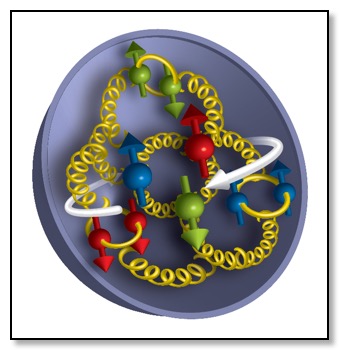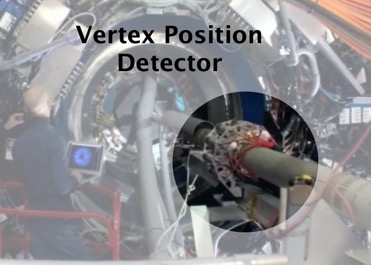Physicists Narrow Search for Solution to Proton Spin Puzzle
November 05, 2014
New RHIC results reveal that gluons make a significant contribution to spin, an important intrinsic particle property; transient sea quarks also play a role.
BNL press release at http://www.bnl.gov/newsroom/news.php?a=25112

How the spins of the building blocks of matter add up: Measurements from RHIC's STAR and PHENIX experiments reveal that gluons (yellow corkscrews) contribute about as much as quarks (red, green, and blue) to the overall spin of a proton. But there is still a mystery to explain what accounts for the rest of the "missing" spin.
Image/caption courtesy Brookhaven National Lab
BNL press release at http://www.bnl.gov/newsroom/news.php?a=25112

How the spins of the building blocks of matter add up: Measurements from RHIC's STAR and PHENIX experiments reveal that gluons (yellow corkscrews) contribute about as much as quarks (red, green, and blue) to the overall spin of a proton. But there is still a mystery to explain what accounts for the rest of the "missing" spin.
Image/caption courtesy Brookhaven National Lab
Search for Muonic Atoms at RHIC (PANIC'14 proceedings), K. Xin
October 30, 2014
Proceedings for International Conference on Particles and Nuclei (PANIC 14) are on arXiv: http://arxiv.org/abs/1410.8037 and at Journal of Physics: Conference Series
Abstract:
We present the search results for muonic atoms on √sNN=200 GeV Au+Au collisions collected by the STAR experiment at RHIC. With the muon identification at low momentum, the invariant mass spectra were reconstructed. Clear signals are observed at the expected atom masses. Two particle correlations show that the production of the daughter particles happens at the same space-time point, presenting the signature of atom ionization. The fraction of primordial muons is extracted from π-μ correlations.
Dielectron production in Au + Au collisions from STAR (HardProbes '13 proceedings), J. Butterworth
October 30, 2014
Proceedings for the 2013 Hard Probes conference published in Nucl.Phys.A 932(2014)318 doi:10.1016/j.nuclphysa.2014.09.080
Abstract: We present the systematic study of dielectron production from minimum bias Au + Au collisions at √sNN=19.6, 39, and 62.4 GeV along with the production from minimum bias Au + Au collisions at 200 GeV for reference. The spectra are compared to simulated hadronic contributions that do not contain ρ-meson contributions. In each comparison, there is an excess in the dielectron yield that is consistent with a medium modified ρ -meson and shows no dependence on √sNN. To further understand the excess, the spectra are compared to the simulated hadronic contributions plus model calculations that include contributions from the medium and ρ-mesons with a broadened spectral function. These comparisons are consistent within uncertainties.
Abstract: We present the systematic study of dielectron production from minimum bias Au + Au collisions at √sNN=19.6, 39, and 62.4 GeV along with the production from minimum bias Au + Au collisions at 200 GeV for reference. The spectra are compared to simulated hadronic contributions that do not contain ρ-meson contributions. In each comparison, there is an excess in the dielectron yield that is consistent with a medium modified ρ -meson and shows no dependence on √sNN. To further understand the excess, the spectra are compared to the simulated hadronic contributions plus model calculations that include contributions from the medium and ρ-mesons with a broadened spectral function. These comparisons are consistent within uncertainties.
RHIC featured at NPR's Science Friday: How to Make Quark Soup
October 20, 2014
Watch at this direct link to PRI's video. Or, go to PRI's Science Friday website at How to Make Quark Soup and find audio and video links.
RHIC featured on the Science Channel
August 15, 2014
The Relativistic Heavy-Ion Collider (RHIC) featured in "How The Universe Works" on the Science Channel. With STAR's Mike Lisa (OSU) explaining RHIC's role in exploring the building blocks of matter.
Fluctuations & Particle Identification Workshop
May 23, 2014
The STAR Fluctuations & Particle Identification workshop, at Rice University on May 23-25, 2012, will focus on the topics of fluctuations in heavy ion collisions and the techniques used for particle identification in the analysis of these collisions. At this workshop, STAR experimentalists and invited theorists will discuss the theory, the analysis methods, and the results, with the goal of further developing the plan towards the publication of final results. The consistent and effective use of the particle identification capabilities of the TPC dE/dx, the Time of Flight system, and the calorimeters, is a particularly crucial part of fluctuation analyses and will also be discussed at this meeting.
The Impact of the US on CMS
March 20, 2014
A couple of videos that advertise the role of the US in CMS h/t Don Lincoln (FNAL)
- A short (3:30m) version: https://www.youtube.com/watch?v=Zjg9CMVhbbU
- A longer (7:30min) version https://www.youtube.com/watch?v=9Imeiu83-iM
STAR experiment featured in Apple's "30 years of Mac" commercial
March 04, 2014
The STAR experiment at Brookhaven National Lab is featured in one of the fifteen locations of Apple's tribute to "30 years of Mac". It starts 46 seconds into the video clip at the link below.
http://www.apple.com/30-years/1-24-14-film/
Look for two of our BNL colleagues in front of the detector (Paul and Bill) and for one of the T.W. Bonner Lab's contributions to the experiment, the VPD (vertex position detector).

http://www.apple.com/30-years/1-24-14-film/
Look for two of our BNL colleagues in front of the detector (Paul and Bill) and for one of the T.W. Bonner Lab's contributions to the experiment, the VPD (vertex position detector).

The other contribution, the TOF, is a bit more difficult to find behind all the tubes and cables …
